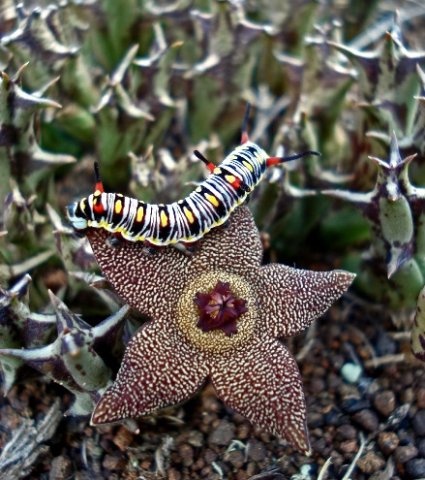Orbea cooperi intimidated

Author: Ivan Lätti
Photographer: Judd Kirkel Welwitch
It is tough on any flower to be eaten instead of receiving the chance of setting seed in accordance with its purpose. There may be insult added to injury when the enemy that does the damage happens to be more floral than the flower itself. These things have to be endured by many in the world where all the living of necessity devour carefully selected or serendipitous assortments of other living things; all living off each other simply because theres no other way.
This Orbea cooperi flower is beaten for colour flamboyance by its caterpillar visitor, (also) adorned with pointy protrusions. The picture does not tell the story of how it ends for the flower (or its visitor). The visitor may be intent upon eating the flower or only consume any nectar it may have produced.
Otherwise it might be showing off its colours upon a suitable background. Alternatively it may be hiding this recklessly conspicuous colouring through camouflage, also upon a suitable background, given the eyesight of friends or foes. Or it may merely be paying its respects to the flower, based on a recognised likeness suggesting affinity or kinship.
Exploring the motives of behaviour displayed by other species in human terms may delude. One should not underestimate the functionality of features observed in simple life forms: Complex and clever looking adaptations to the environment may have come about through systematic processes. Such systematic processes are here not cognition driven, but come about through the selective survival of only those randomly produced forms proving their merit in prevailing conditions.

